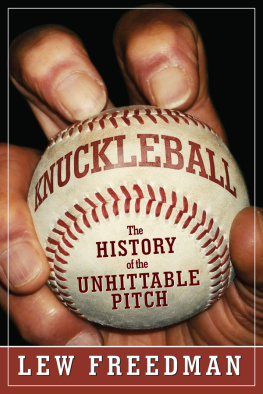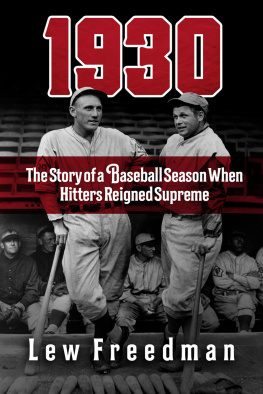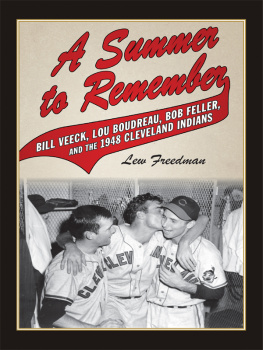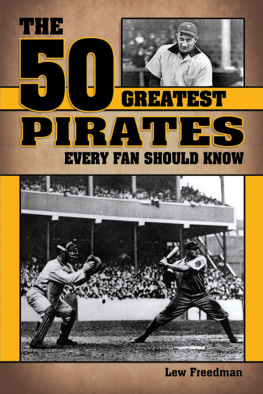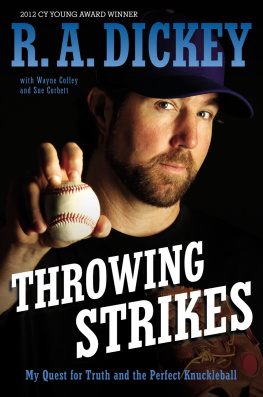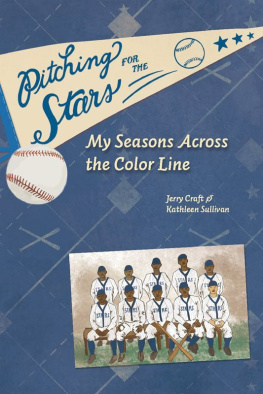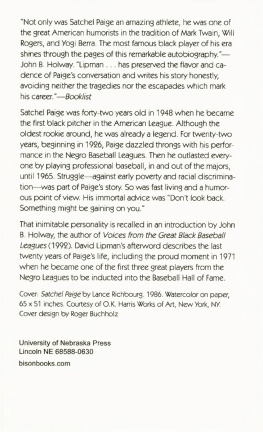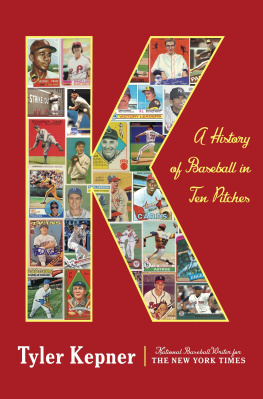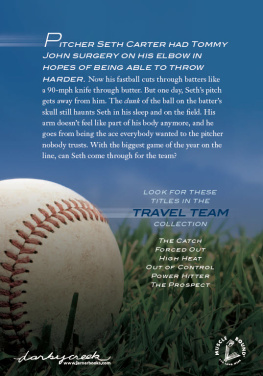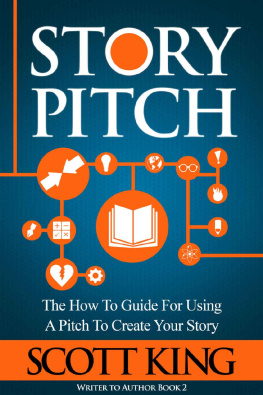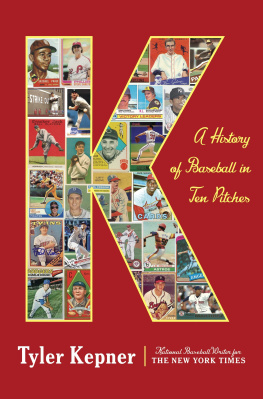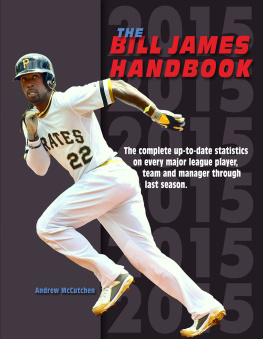Copyright 2015 by Lew Freedman
All rights reserved. No part of this book may be reproduced in any manner without the express written consent of the publisher, except in the case of brief excerpts in critical reviews or articles. All inquiries should be addressed to Sports Publishing, 307 West 36th Street, 11th Floor, New York, NY 10018.
Sports Publishing books may be purchased in bulk at special discounts for sales promotion, corporate gifts, fund-raising, or educational purposes. Special editions can also be created to specifications. For details, contact the Special Sales Department, Sports Publishing, 307 West 36th Street, 11th Floor, New York, NY 10018 or .
Sports Publishing is a registered trademark of Skyhorse Publishing, Inc., a Delaware corporation.
Visit our website at www.sportspubbooks.com.
10 9 8 7 6 5 4 3 2 1
Library of Congress Cataloging-in-Publication Data is available on file.
Cover design by Rain Saukas
Cover photo courtesy of Phil Niekros knuckleball grip by Lew Freedman.
Print ISBN: 978-1-61321-766-5
Ebook ISBN: 978-1-61321-794-8
Printed in the United States of America
To all the pitchers who made a career out of throwing the knuckleball, the most difficult pitch to rely on.
CONTENTS
PREFACE
I LOVE THE knuckleball. I love watching that slow-motion pitch float to home plate, twisting and turning in so many directions. I love watching behemoth sluggers contort themselves into pretzels with their mighty swings at thin air.
Every knuckleball thrown that tantalizes and fools a hitter seems like a victory for the underdog. Conditioned to swat 95 mph fastballs long distances, it is somehow satisfying and amusing to see the best hitters in baseball find themselves incapable of coping with such a tantalizing, innocuous weapon.
It is one thing to be overpowered by a pitch you can barely see. Everyone can identify with the difficulty of connecting safely with a fastball that travels faster than you will ever drive your car. But the knuckleball is a tease; a pitch that looks easy to hit. It is a pitch that everyone in the stands who ever played Little League baseball feels they can hit. And why wouldnt they, since the radar gun might tell them the pitch sailed into range at something like 62 mph?
Of course if it were that easy, everyone would do it. Not everyone can hit the knuckleball. Not everyone can throw the knuckleball, although half of the people in the sport think they can because it looks so easy to throw. Maybe it is easy to throw, but not to control. Thats the trick to the infamous pitch.
A fundamental tenet of baseball is the balance between the offense in the persona of the hitter standing in the batters box and the pitcher standing on the mound. This duet has been the hallmark of baseball since before the National League was founded as the first professional league in 1876.
The pitcher has an arsenal of flavorful choices to throw, although many heavily rely on just a couple of selections. The fastball is predominant. The curveball and the changeup are generally necessities. Always looking for an edge over the course of baseball history, pitchers have tinkered and invented new pitches, experimenting with new ways to get batters out. We have seen the slider, the splitter, the fork ball, the cutter, the spitter, the screwball, and the slurve. Some have been outlawed, while others have fallen out of fashion.
The hitter, preferably with 20-20 vision, studies the pitchers motion, tendencies, habits, and grips, and tries to figure out what the hurler will throw to him. If all goes well he guesses accurately and lays lumber against the horsehide and it travels a great distance where no fielders stand to seize it.
If ever there were a wild card in the mix to confuse both batter and pitcher, however, it is the knuckleball. The knuckleball answers to no master. It can be a deadly weapon or the death of its practitioner. It is safe to say that thousands of players know how to throw a knuckler, but only a tiny number have ever understood how to make it work. The knuckleball is shrouded in mystery. On the same pitch, the batter may wonder how he did not smash it into the center field bleachers and the pitcher may wonder how the heck he registered a strike.
The knuckleball has been around as part of baseball for more than a century. Historians suspect, but cannot agree with certainty, who invented it. The knuckleball is so baffling that it handicaps not only hitters, but pitchers who set out to employ it. The knuckler drives both hitters and pitchers crazy. Often a pitch of last resort to save a career, there is no guarantee even a blind-faith commitment to the knuckler will bring salvation.
Those who succeed by throwing the knuckleball share a special bond and camaraderie because their brotherhood is so small. Periodically, it seems possible that the knuckleball will die out and disappear altogether, but it always experiences a revival. Perhaps most amazingly, at least four devotees of the knuckleball have ridden its quirky nature into the Hall of Fame.
Appropriately, the story of the knuckleballmuch like the flight path it follows between the mound and the plateis not a straight line.
Lew Freedman
INTRODUCTION
N OT ONLY IS the knuckleball the all-time oddball baseball pitch, it isnt even thrown with the knuckles. To throw a worthwhile knuckler the pitcher must dig in with his fingertips for control.
Go figure.
Phil Niekro stood in a wide open room inside Coolray Field on an off-day for the Gwinnett Braves, the AAA affiliate of the Atlanta Braves in suburban Lawrenceville, Georgia. In his right hand nestled a baseball. Niekro, who had just turned seventy-five, manipulated the ball into position and showed off the knuckleball grip that carried him to most of his 318 career victories and a place in baseballs Hall of Fame.
Not a single knuckle came into contact with the borrowed baseball that displayed the writing Official Ball International League. If Niekro had rested his knuckles on the ball, his manicurist would have been surprised.
A short while earlier, Niekro, the most prominent living supporter, endorser, teacher, and practitioner of the knuckleball, was asked a simple question that has no simple answer: What is a knuckleball? It was suggested that might be a provocative question.
It aint all that provocative an answer, he said. Ive been trying to figure that out. Im still trying to figure it out.
Since Niekro was first tutored on the nuances of the knuckler roughly sixty-five years ago, he is the most successful starting pitcher to employ it in baseball history and is on speed dial as Dr. Phil for knuckleball throwers in need of emergency lessonsif he cant define it, the rest of the world might as well give up.
It is not as though Niekro is a magician like David Copperfield, Doug Henning, or Ricky Jay, who refuse to unveil the secrets of the trade to spoil the illusion for the audience. Indeed, Niekro is generous with thoughts, ideas, and instruction about the knuckleball for anyone who asks, especially professionals in serious need of insights and coaching.
Yet for all of his opennessand that of other knuckleball artists who have preceded and followed him as exemplars of the knucklerthe pitch defies the cleverest minds attuned to trying it. Unlike the professional magicians, knuckleball illusionists will happily tell you how to throw the pitch, what it is supposed to do, and explain its effects, but they cannot ensure that the novice will be capable of putting it to good use.
There are basically two categories of baseball pitches. One is the fastball, the absolute pure, heat-seeking missile that might buzz past a batters head so swiftly he can only see a blur and most definitely cant get his bat around fast enough to make good contact. The other is just about everything else, a curve, splitter, or whatever. Those pitches spin either away from or in towards a batter. Then there is the knuckleball, which neither arrives from the mound 60 feet, 6 inches away at the speed of a rocket, or with the spin of a top. A knuckleball is characterized by its lack of spin. To the hitters practiced eye it just kind of meanders to the plate like a butterfly on a vague mission; a big, fat, juicy meatball of a pitch waiting to be slugged out of the park.

